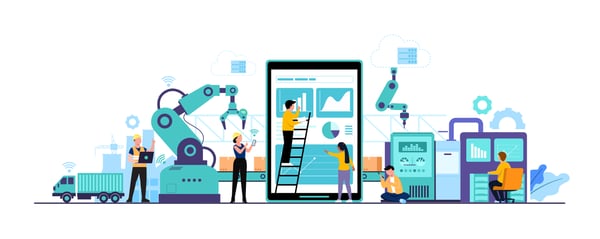In our previous blog post together with our partner IFS Ultimo, we introduced how workflows help improve maintenance efficiency at industrial companies. According to Forbes1, production sites that have inefficient maintenance processes might spend up to four times as much time on maintenance. So yes, efficient maintenance processes powered by smart workflows can make a big difference in your bottom line!
Get a quick start with our top five tips
In this post, we have gathered our top five tips if you want to improve the efficiency of your maintenance workflow, or for that matter implement maintenance workflows. They are not done in a day, but it’s a great place to start to ensure your production stays competitive.
1. Use EAM software that helps you track assets and maintenance
For starters, you need a system that can help you collect all data related to your assets. Just one production unit can consist of thousands of parts that need to be maintained and switched at the correct intervals, which is almost impossible to keep track of without help. Here IFS Ultimo is a great choice if you are a mid-size company that is looking for an EAM system that is easy to implement and easy to use, without compromising functionality. You can read more about how for example IFS Ultimo improves maintenance operations here.
2. Create a good foundation for your workflows
We all know the expression ‘Garbage in, garbage out’ which refers to the concept that in any system, the quality of output is determined by the quality of the input. So yes, once you have an EAM system in place you will need to make sure that you populate it with the data needed to create well-established processes that you base your workflows on. Here, standardization is key to efficiency. Ensure that workflows have clear, standardized procedures and guidelines that all team members can understand and follow.
3. Empower your technical staff
Provided that you have accomplished steps 1 and 2, the next step is to ensure that your established workflows help your staff in their daily work. This is efficiently done through work orders assigned in the system. One important thing here is availability. Most staff working on the production floor don’t have easy access to a computer. So make sure that your EAM software has good mobile functionality so that technical staff can easily access work orders and record their tasks on the go. IFS Ultimo offers this functionality through its mobile app ‘Ultimo Go’.
4. Improve cross-functional communication and collaboration
Make it easy to connect with colleagues, regardless of where they are located. When your staff are unable to solve a task with only the data in the EAM system they need help, so so that the problem can be solved as quickly and efficiently as possible. By adding a remote visual assistance tool to IFS Ultimo, you make it easy to collaborate by using a joint video stream and guide tools to highlight what actions need to be taken. Not only does this help staff to solve issues faster, but it also helps with knowledge sharing across your organization. You can read more about how a remote visual assistance solution can be used for troubleshooting here.
5. Collect data, analyze, adjust, repeat.
Implement performance monitoring and measuring to track the progress and effectiveness of your workflows. Use the data collected to identify areas for improvement and make data-driven decisions. This might sound straightforward, and in many ways it is, but the hard thing is to set aside time to actually do it.
If you pick a good EAM system you can get a lot of support identifying where there is room for improvement. This data can also come from records and recordings from remote visual assistance calls, which are usually initiated when you need to solve an unexpected problem. In other cases you might simply lack enough data and the starting point for improvement will be how to collect that data.
One final piece of advice before you start
One step that we have not listed above, but is crucial for long-term efficiency, is to establish a culture of continuous improvement. By regularly reviewing and optimizing workflows, organizations can identify areas for enhancement, reduce waste, and adapt to changing market conditions. Continuous improvement ensures that production processes remain efficient and competitive over time, leading to better outcomes and sustained growth.
To sum up, leveraging an Asset Management System in conjunction with a Remote Visual Assistance Solution for your maintenance workflows can effectively optimize asset utilization, minimize downtime, and significantly improve overall operational efficiency. This is precisely why IFS Ultimo and XMReality have joined forces in a strategic partnership, offering user-friendly solutions that empower organizations to enhance efficiency and productivity.
1 Forbes, 'Unplanned Downtime costs more than you think'







